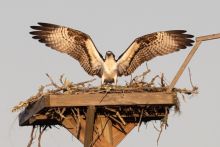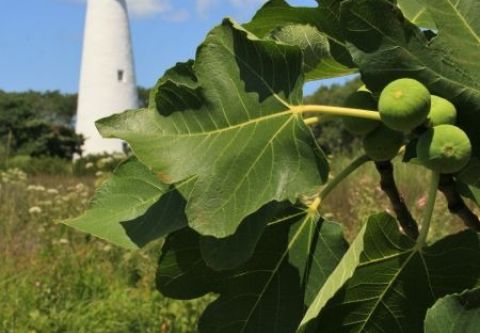
There are so many signs of spring around the Outer Banks right now: sunshine, college spring breakers, people on the beach in bathing suits instead of hoodies, daffodils popping up, trees blooming, otters playing in the creeks, anglers returning to the piers, people filling up restaurant patios and decks …
One of my favorite signs of spring is the return of the ospreys. There are two ospreys that live close to my neighborhood, and when we start hearing their high-pitched calls every year in early March, we know spring is just around the corner.
The ospreys we see on the Outer Banks in the spring, summer and fall spend their winters where it's warmer, usually Central or South America. That means these birds have just journeyed 2,000 or 3,000 miles or more!
Once they find a good nesting spot, ospreys, who usually live in pairs, come back to it every year. For the first few weeks in March they are super busy building their nests — in between lots of fishing. You’ll see them flying with big sticks, Spanish moss, vines and all kinds of human flotsam and jetsam. I’ve seen them do flybys on a tree and grab dead branches right off the tree. And if you ever get up close to a nest, you’ll see some pretty crazy trash in there. Once when boating past an osprey nest on a channel marker, I spotted a hot pink hair brush tucked in between the layers of sticks.

According to AllAboutBirds.com, the male osprey usually arrives in the area first, finds the old nesting spot (usually high atop nesting poles, pilings, channel markers and treetops) and starts collecting nesting material. There may be some of their old nest remaining from the previous year, or the bird may have to start from scratch. The female arrives a little later and usually is the one to do most of the arranging of the nest. Then it’s time to lay some eggs and raise some young, all the while fishing, fishing, fishing.
Ospreys are easy to spot. They’re not as big as pelicans, but they are one of the biggest, most conspicuous birds around here. The body is dark brown with a white stomach, legs and head, and they resemble an eagle, just smaller. They stand about 21 to 24 inches tall and have a wide, crooked wing span that almost looks like an M. Their wingspan can be five feet wide.
Ospreys are excellent fishers. You’ll see them hovering over the water and plunging into the water to catch fish. It looks like they are going in headfirst, but they actually enter feet first to catch fish with their talons. Osprey talons are fascinating. Each leg has four talons, two on the front and two on the back that form a circle hook. Inside their talons are spikes that help them to grab a slippery fish.

Ospreys can dive at 30 miles per hour and have been clocked at 50 miles per hour by the time they hit the water. After their dive, they take off quickly and shake off vigorously to remove water from their feathers. I’ve noticed, and ncwildlife.org confirms, that they always carry their captured fish with the head forward. I always wondered how in the world they do this, but researching for this blog I learned that they can do this because their outer talons can rotate forward and backward, which allows the osprey to align the fish’s head in the direction of flight for the best flight aerodynamics!
Osprey carry their fish to a high place or their nest to eat it, sometimes very long distances. Because they are such good fliers, they can carry 25 times their body weight. Sometimes, they grab fish that are just too big for them, though; like the time the osprey that lives near the Manteo High School playing fields accidentally dropped a big fat trout on the soccer field, stopping play while someone ran out to grab it.
Osprey keep the same mate for years, some for life, though they may have more than one mate over their lifespan. According to ncwildlife.org, the female usually lays two to four eggs, and incubation lasts about four to five weeks. The female does most of the incubation, but the male sits in when she leaves the nest to feed. When the young hatch, the male will bring the female and young food. The young remain in the nest for about eight weeks after hatching, and it's fascinating to watch them fledging and learning to fly and fish. Because they are so big, it's easy to see them doing this. After migrating in the fall, the young remain south on the wintering grounds until they are two years old. At that time they again migrate north. Ospreys normally start breeding at about three years of age.

Ospreys are really fun to watch, and they are very vocal with a high-pitched call so you know when they are around. Anytime you're close to the sound, there's a likelihood an osprey is close by. A couple of great places to watch them are at Basnight's Lone Cedar Cafe and Sugar Creek Restaurant, both on the Nags Head-Manteo Causeway. Both restaurants have resident osprey nests right outside their windows. Look for them when driving over the Wright Memorial Bridge and the Washington Baum Bridge too. Keep a lookout too for other spring arrivals, too: laughing gulls, fish crows, purple martins and warblers to name a few.
Free Birding Tours
If you’re interested in Outer Banks birds, be sure to check out the free Pea Island Bird Walk. Close to 400 species of birds live on or pass through Pea Island National Wildlife Refuge, and the bird walks are great ways to spot some of them — with someone who can tell you what you’re seeing and hearing! Whether you're a beginner or an expert, you'll enjoy this casual stroll beside North Pond. Field guides, binoculars, sunscreen, and insect repellent are recommended. Some field guides and binoculars will be available for loan. Pea Island Bird Walks are held year-round on Fridays from 8 to 9:30 a.m. Meet at the Pea Island National Wildlife Refuge Visitor Center, located on N.C. Highway 12 approximately 4 miles south of Oregon Inlet and 9 miles north of Rodanthe.

All photos in this blog are courtesy of birder extraordinaire Jeff Lewis. Follow him on Facebook to see his amazing Outer Banks bird photos.


 Molly Harrison is managing editor at OneBoat, publisher of OuterBanksThisWeek.com. She moved to Nags Head in 1994 and since then has made her living writing articles and creating publications about the people, places and culture of the Outer Banks.
Molly Harrison is managing editor at OneBoat, publisher of OuterBanksThisWeek.com. She moved to Nags Head in 1994 and since then has made her living writing articles and creating publications about the people, places and culture of the Outer Banks.

